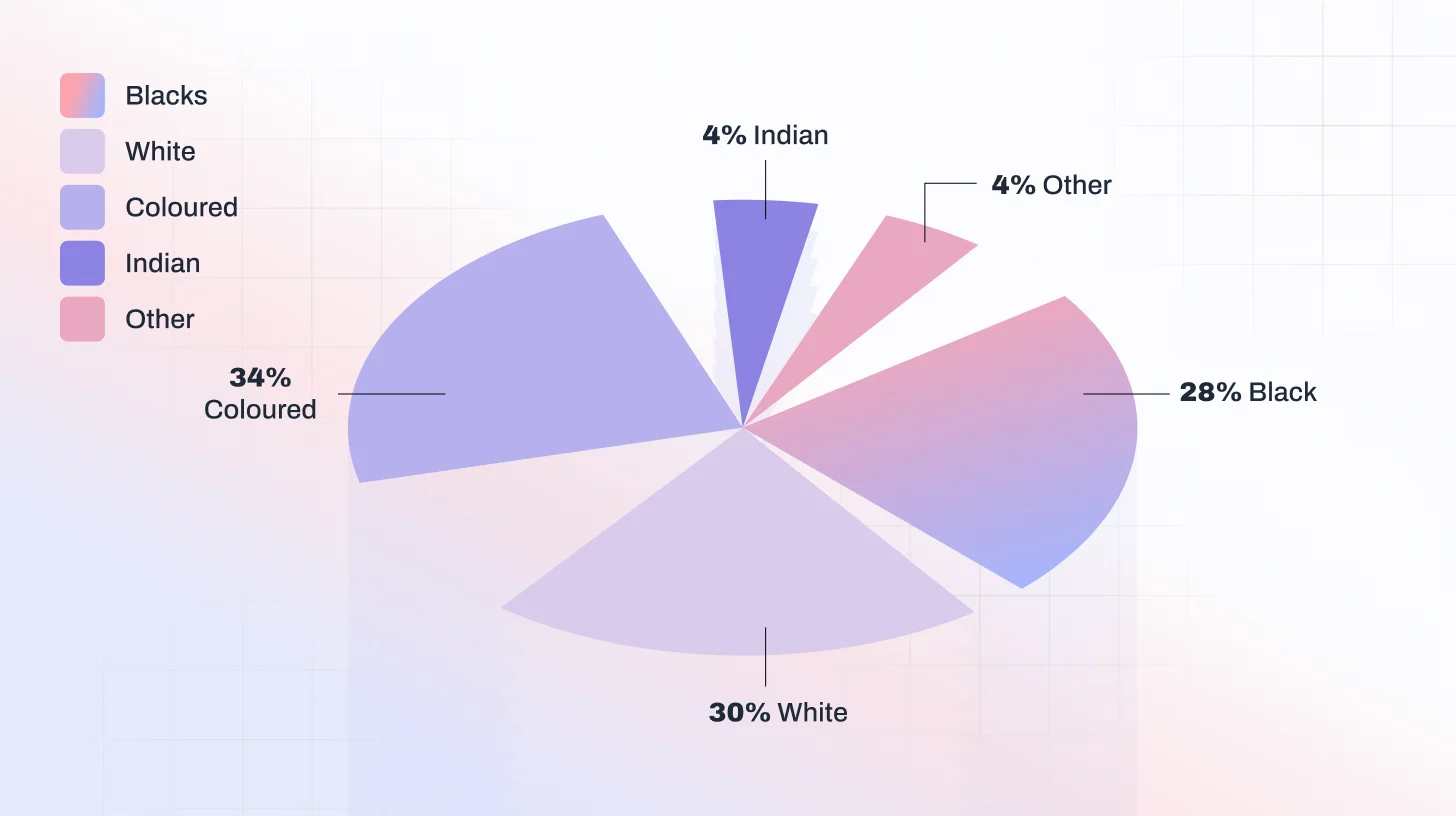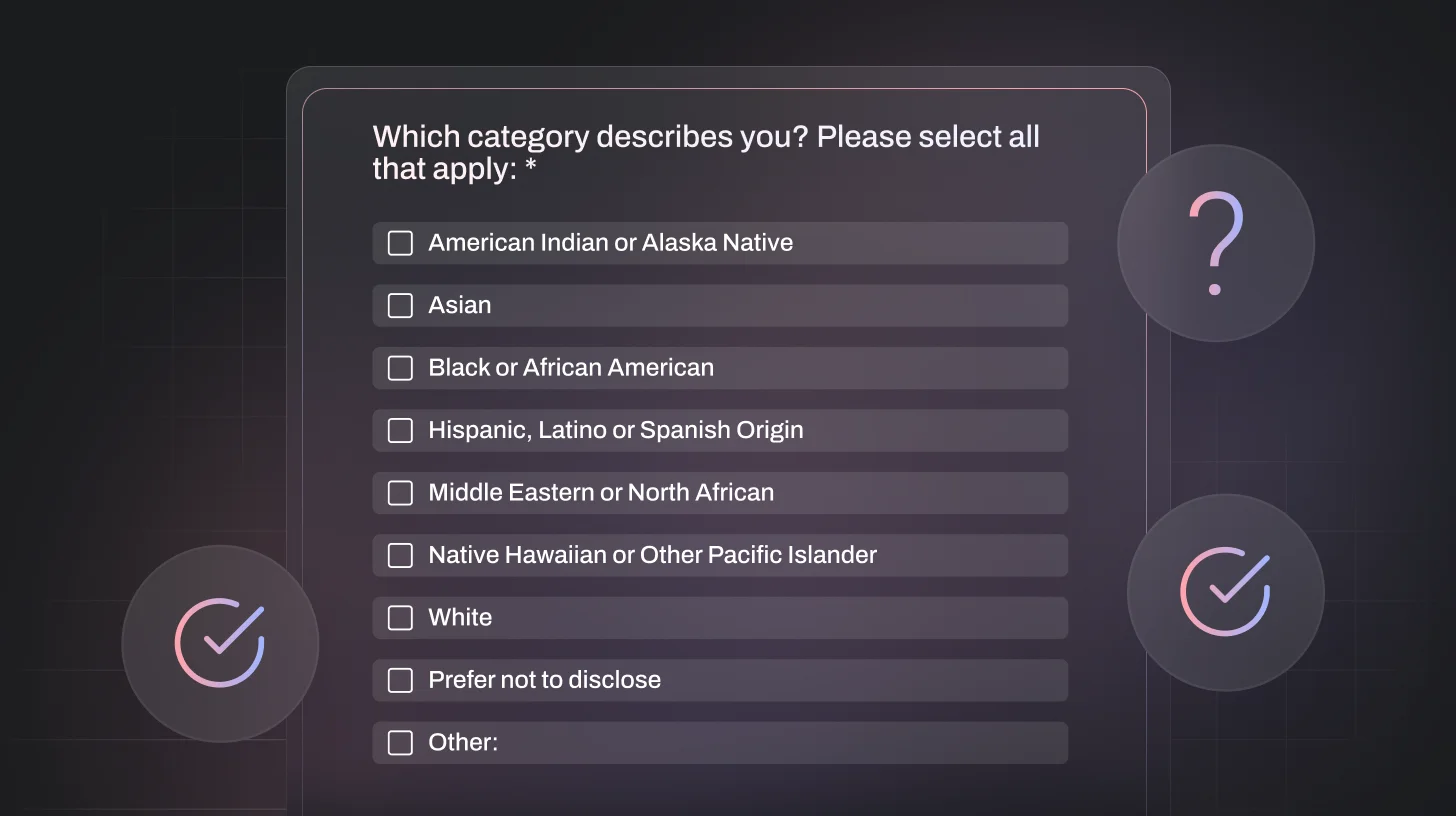 Blog
Blog How to Ask Ethnicity Survey Questions That Build Trust and Inclusivity
How to Ask Ethnicity Survey Questions That Build Trust and InclusivityHow to Ask Ethnicity Survey Questions That Build Trust and Inclusivity

Ethnicity survey questions, often grouped with race and nationality, form a vital part of demographic research. These questions help organizations understand the diverse backgrounds, cultures, and experiences that shape how people think, decide, and respond.
Like other demographic questions, ethnicity can be a sensitive topic. It isn’t static or one-dimensional; identity evolves with culture, language, history, and personal experience. That’s why asking these questions correctly matters both ethically and analytically.
In this guide, we’ll explore how to design thoughtful ethnicity survey questions that balance inclusivity, accuracy, and respect while helping teams use this insight to make smarter, more human-centered decisions.
TL;DR
Ethnicity survey questions help organizations understand the cultural and social backgrounds that shape people’s perspectives and experiences. When crafted with care, they provide insights that strengthen inclusivity, guide better business and HR decisions, and ensure compliance with privacy laws. However, asking them without context or sensitivity can lead to confusion or alienation. This guide walks you through how to design respectful, clear, and ethical ethnicity survey questions and how AI-powered feedback tools like TheySaid make the process faster, smarter, and more human.
What are ethnicity survey questions?
Ethnicity survey questions are a core part of any demographic section in a survey. They help you understand the cultural and ancestral backgrounds of your respondents' insights that go far beyond surface-level data.
These questions capture how people identify themselves in terms of heritage, culture, and sometimes even language or regional ties. In other words, ethnicity questions reflect where someone’s roots and cultural identity come from, not just where they live today.
In research and business contexts, asking about ethnicity isn’t just a formality; it’s a way to connect data with human experience. For example, in market research, ethnicity insights reveal how different groups perceive brands, products, or messages. Employee or DEI surveys help organizations measure representation and inclusivity more accurately.
Read: Demographic Survey Questions: Best Practices and Examples
Difference between race, ethnicity, and nationality
When designing demographic or ethnicity survey questions, it’s important to understand the difference between race, ethnicity, and nationality. These terms are closely related, but they represent different parts of a person’s identity, and using them correctly helps you collect data that’s accurate, respectful, and meaningful.
Race
Race refers to physical traits or characteristics that societies often use to categorize people, such as skin color, facial features, or hair type. Although race is largely a social construct, it still appears in many official surveys or censuses for reporting and compliance purposes.
Common examples include:
- White
- Black or African American
- Asian
- American Indian or Alaska Native
- Native Hawaiian or Other Pacific Islander
Ethnicity
Ethnicity is more about culture than appearance. It reflects shared ancestry, traditions, language, and social heritage. Two people may belong to the same race but identify with completely different ethnic groups.
Example categories:
- Hispanic or Latino/a/x
- Han Chinese
- Punjabi
- Arab
- Irish
- Yoruba
Nationality
Nationality refers to a person’s legal relationship with a country, typically shown through citizenship or birthplace. It’s about where someone belongs politically or geographically, not necessarily where their ancestors came from.
For example: Someone might have British nationality, identify as Indian (ethnicity), and be classified as Asian (race).
Also Read: 20+ Diversity, Equity, And Inclusion Survey (DEI) Questions
When to use the ethnicity question in surveys?
You should use ethnicity questions in surveys only when the information directly supports your goals. Because ethnicity is a sensitive form of demographic data, it should be included thoughtfully and only when it adds real value. These questions are especially useful in DEI assessments, where organizations need to understand representation and identify gaps in diversity and inclusion.
They are also important in HR surveys to analyze workplace demographics, track fair hiring practices, and design more inclusive employee programs.
In academic, social, and public health research, ethnicity data ensures that studies reflect diverse populations and avoid biased or incomplete results. Schools and community organizations also use ethnicity questions to understand the cultural makeup of students or residents and to improve support services.
In market research, ethnicity insights help businesses tailor products, messaging, and customer experiences for multicultural audiences. In some cases, such as government reporting, grant applications, or census work, collecting ethnicity information is required by law.
However, ethnicity questions should not be used if they aren’t relevant to your survey, if you can’t protect respondent privacy, or if you don’t have a clear reason for collecting the data.
List of ethnicities for survey questions
When you’re building an ethnicity question for a survey, the goal is to provide enough options for people to identify accurately without overwhelming them. The best practice is to base your list on recognized demographic standards (like those from the U.S. Census Bureau, U.K. Office for National Statistics, or Statistics Canada) and to always include “Other (please specify)” and “Prefer not to say” options.
Below are examples of ethnicity categories you can adapt based on your audience and region.
Common Ethnicity Categories (U.S. Standard)
These categories follow the U.S. Census model and are widely used in academic, HR, and market research contexts.
- Asian or Asian American
- Black or African American
- Hispanic or Latino/a/x
- Middle Eastern or North African
- Native American or Alaska Native
- Native Hawaiian or Other Pacific Islander
- White
- Another ethnicity (please specify): __________
- Prefer not to say
U.K. Ethnicity Categories (ONS Standard)
The Office for National Statistics (ONS) uses slightly different groupings to reflect the U.K.’s diverse population.
White
- English, Welsh, Scottish, Northern Irish, or British
- Irish
- Gypsy or Irish Traveller
- Any other White background
Mixed or Multiple ethnic groups
- White and Black Caribbean
- White and Black African
- White and Asian
- Any other Mixed or Multiple background
Asian or Asian British
- Indian
- Pakistan
- Bangladeshi
- Chinese
- Any other Asian background
Black, African, Caribbean, or Black British
- African
- Caribbean
- Any other Black background
Other ethnic group
- Arab
- Any other ethnic group
Canadian Ethnicity Categories (Statistics Canada)
Canada often uses “ethnic origin” or “visible minority” categories:
- South Asian (e.g., Indian, Pakistani, Sri Lankan)
- Chinese
- Black
- Filipino
- Latin American
- Arab
- Southeast Asian (e.g., Vietnamese, Cambodian, Malaysian)
- West Asian (e.g., Iranian, Afghan)
- Korean
- Japanese
- Indigenous Peoples (First Nations, Métis, Inuit)
- White
- Other (please specify): __________
- Prefer not to say
Global or Custom Ethnicity Options
If your audience is international, it’s best to offer a broad, flexible list that reflects global diversity. You can group responses by region rather than specific national identities:
Suggested Global Categories:
- African / African Diaspora
- East Asian
- South Asian
- Southeast Asian
- Middle Eastern / North African (MENA)
- European
- Latin American / Hispanic
- Indigenous / First Peoples
- Pacific Islander / Polynesian
- Mixed or Multiracial
- Other (please specify): __________
- Prefer not to say

Asking Race and Ethnicity Questions in a Survey: Examples & Modern Approaches
Now comes the big question: how do you actually ask race and ethnicity questions in a survey without making it awkward or overly formal?
Race and ethnicity touch on identity, belonging, and cultural things that are deeply personal. So, how you ask matters just as much as what you ask.
Below are three thoughtful approaches that help you frame these questions respectfully while keeping your data reliable and inclusive.
Approach 1: The Conversational “Get to Know You” Style
This method helps respondents ease into demographic questions by starting with a more human, conversational tone. Instead of jumping directly into race or ethnicity, you build trust first.
Example Flow:
- What’s your first name?
- Great to meet you, Jack. Where do you call home?
- We’d love to better understand your background. Which cultural or ethnic group do you identify with most?
This soft introduction makes demographic questions feel less intrusive. It’s especially useful in employee engagement surveys, customer research, or community programs where people value a friendly tone.
Platforms like TheySaid make this even smoother by letting participants answer with voice so they can explain their identity in their own words, naturally and comfortably.
Approach 2: The “Describe Yourself” (Open-Ended) Approach
Sometimes, giving people space to describe themselves is the most inclusive option. Instead of forcing them to choose from fixed categories, let them define their own identity.
Examples:
- “How would you describe your ethnic or cultural background?”
- “What communities or heritages do you identify most strongly with?”
- “If you were to describe your cultural background in your own words, what would you say?”
You can also tailor the phrasing to your audience.
For instance:
- A healthcare organization could ask:
“Are there cultural or ethnic factors that shape how you approach health or wellness?” - A tech company might ask:
“Do you identify with a particular ethnic or cultural background that influences your perspective or experience?”
TheySaid’s AI can analyze these narrative responses and automatically cluster similar answers, turning qualitative insights into measurable data without losing authenticity. Sign up for free!
Approach 3: The Combined Question Format
For large-scale or standardized surveys, combining structured and open-ended formats gives you the best of both worlds: clean data and human context.
Here’s how a combined structure might look:
Question 1: Race (Select all that apply)
- African or African diaspora
- East Asian (e.g., Chinese, Korean, Japanese)
- South Asian (e.g., Indian, Bangladeshi, Sri Lankan)
- Middle Eastern or North African
- Hispanic, Latino, or Latin American
- Indigenous or First Nations
- White or European
- Mixed or multiple ethnic backgrounds
- Another group not listed (please specify): _______
- Prefer not to say
Question 2: Ethnicity or Cultural Origin
- Are you of Hispanic, Latino, or Spanish origin?
- Yes
- No
- Prefer not to say
Question 3: Cultural Identity (Optional)
“Are there any other cultural, tribal, or heritage identities that you feel define you?”
Question 4: Representation & Inclusion
“Do you feel people of your racial or ethnic background are fairly represented in our organization/community?”
- Yes
- No
- Unsure
Question 5: Open Reflection
“What’s one way we could make our community more inclusive of all cultural or ethnic backgrounds?”
This layered approach respects how people self-identify while giving organizations actionable insights into representation and inclusion.

Advantages of ethnicity survey questions
When done right, ethnicity survey questions offer valuable insights that go beyond demographics. They help organizations make smarter decisions, build inclusive teams, and connect with customers on a cultural level.
Better Business Insights
Collecting ethnicity data helps identify who your audience really is. A streaming service, for example, might find that certain cultural communities prefer regional content, helping shape recommendations and marketing campaigns.
Inclusive Workplace Decisions
In HR surveys, ethnicity questions reveal representation gaps. This enables leaders to promote equity in hiring, promotions, and engagement programs while fostering a stronger sense of belonging.
Read: 40+ Diversity Survey Questions to Build a More Inclusive Workplace
Targeted Marketing and Product Design
Knowing your audience’s ethnic background can inform product design and messaging. For instance, a skincare brand might discover that certain products resonate better with specific skin tones or cultural preferences.
Highlighting Inequities
Ethnicity data can expose unfair patterns such as a lack of advancement opportunities for certain groups, allowing organizations to act before issues escalate.
Building Trust and Transparency
When respondents see that you value diversity and handle their data responsibly, they’re more likely to respond honestly and feel respected.
With TheySaid, you can easily collect, categorize, and analyze race and ethnicity data using AI-driven tagging and voice-based responses. The platform helps teams ensure every identity is represented without the friction or bias that often comes with traditional forms.
Limitations of ethnicity survey questions
While ethnicity survey questions can help improve inclusivity, they also come with challenges. If asked poorly, they can confuse or even alienate respondents.
Risk of Alienation
Highlighting ethnicity without context may make respondents feel singled out or uncomfortable. Always explain why you’re asking to build trust and openness.
Confusion
Ethnicity is complex and interpreted differently across cultures. Vague or narrow options can confuse people of mixed or unique backgrounds. Include “Other” and “Prefer not to say” to keep it inclusive.
Risk of Offense
Ethnicity is personal. Asking without clear intent or sensitivity can seem intrusive. Make it optional and clarify how responses will be used.
Regional and Legal Issues
Terms differ across countries, and privacy laws like GDPR or CCPA apply. Always localize your question sets and stay compliant.
Best practices for ethnicity survey questions
Getting ethnicity survey questions right is about balancing being respectful, precise, and transparent while still gathering meaningful insights.
Start with Context: Before asking, explain why you’re collecting ethnicity data. When respondents know it’s for inclusivity, not labeling, they respond with more trust.
Use Respectful, Updated Language: Language evolves. Always review your phrasing to make sure it reflects how people identify today. Avoid outdated or overly broad terms.
Give People Control: Include flexible options like “I identify as…”, “Other (please specify),” or “Prefer not to say.” Letting people self-identify creates comfort and accuracy.
Be Consistent, Not Rigid: If you’re surveying multiple regions, adapt the categories to local norms but keep your format clear and comparable.
Test Before You Send: Pilot your survey with a small, diverse group to ensure wording feels inclusive and clear. Adjust based on their feedback; it shows care and awareness.
Respect Anonymity: Keep responses confidential and optional. Ethnicity data should never feel like a requirement; it’s a choice.
Legal and ethical considerations
Ethnicity data is sensitive, and mishandling it can cause harm or compliance issues. Every organization must ensure that its surveys follow both privacy laws and ethical best practices.
Follow Data Protection Laws: Comply with regulations like GDPR, CCPA, and other regional frameworks. Always disclose how data will be stored, used, and shared.
Obtain Informed Consent: Never collect ethnicity data without clear permission. Let respondents know participation is voluntary and that declining won’t affect their experience.
Avoid Misuse of Data: Ethnicity insights should only be used to promote inclusion, fairness, and representation, not for profiling or discriminatory decisions.
Align with DEI Principles: Use ethnicity data to promote equal opportunity, cultural understanding, and fair representation, reinforcing your commitment to ethical leadership.
Handled with empathy and accountability, ethnicity survey data can empower smarter, fairer, and more human-centered decision-making.
Using AI to Improve Sensitivity and Accuracy in Ethnicity Questions
Platforms like TheySaid use AI to detect tone, emotional context, and phrasing risks in real-time survey design. That means teams can automatically flag potentially biased or unclear wording before surveys go live.
How TheySaid Helps:
- Suggests inclusive wording for sensitive demographics
- Analyzes open-ended ethnicity responses with sentiment + cluster analysis
- Protects data privacy through anonymized processing
- Generates diversity reports and DEI insights in minutes
By combining AI with ethical frameworks, TheySaid enables feedback collection that’s both human and data-smart. Book a demo!
FAQs
How should I ask ethnicity questions without offending respondents?
Keep the tone neutral, provide inclusive answer options, and always explain why the data is being collected. For example, clarify that the goal is to promote diversity or improve user experience, not to stereotype or categorize.
What’s the difference between race and ethnicity in a survey?
Race often refers to physical traits (like skin color or facial features), while ethnicity relates to shared culture, language, or heritage. They can overlap, but asking both separately can help capture a fuller picture of your respondents’ identities.
Should ethnicity questions be mandatory in a survey?
No. Always make them optional. Respondents should have the choice to skip personal or sensitive demographic questions, as forcing an answer can reduce trust and completion rates.















.svg)